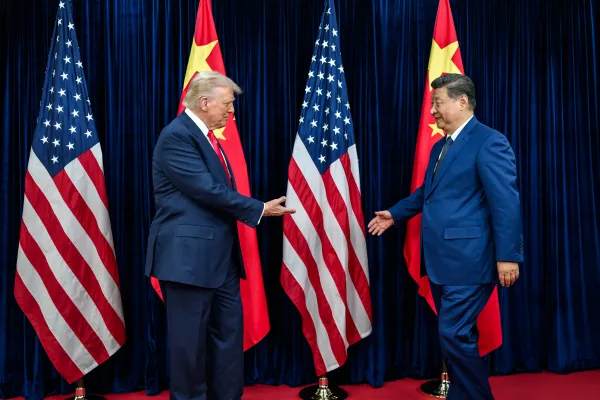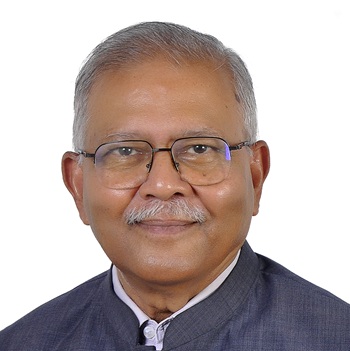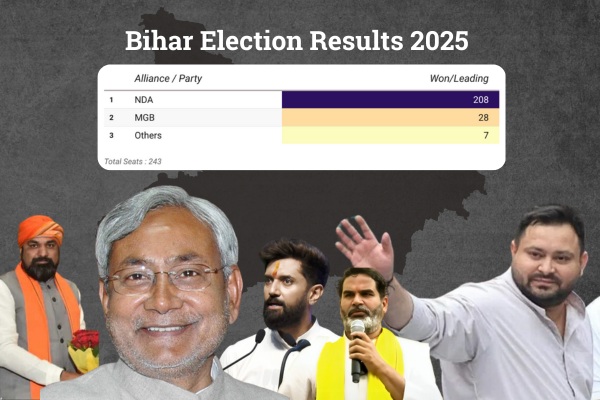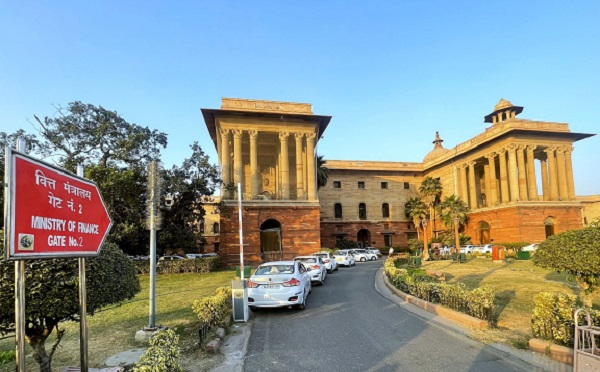.png)
Why This Isn’t a G2 Moment
With power diffused and key regional players asserting autonomy, a US–China duopoly remains far from materialising.


Ashok K. Kantha, a former career diplomat, is now associated with three New Delhi-based think-tanks. Earlier, he served as Secretary (East) in Ministry of External Affairs and Ambassador/High Commissioner to China, Sri Lanka and Malaysia.
November 14, 2025 at 1:03 PM IST
US President Donald Trump’s one‑liner on the eve of his meeting with Chinese President Xi Jinping at Busan on October 30 — “THE G2 WILL BE CONVENING SHORTLY!” — instantly reframed a bilateral summit as a question about geopolitical architecture. The phrase grabbed headlines, reassured some markets, and pushed concerned capitals to ask whether Washington and Beijing were preparing to co‑manage the international order. That rhetorical flourish was useful for optics and domestic political theatre, but headlines do not generate global order and spectacle is not a substitute for durable governance.
The Case Against G2
President Trump’s “G2” remark performed as political theatre rather than a blueprint for shared governance; it shaped perceptions but did not create any commitments, let alone usher in new institutions.
The Busan meeting produced tactical, reversible de-escalation measures that lowered immediate economic and security risk; the resumed military‑to‑military hotlines, narrow regulatory talks and modest tariff adjustments are useful de‑risking steps but do not constitute co‑rule.
China took transactional gains where it suited domestic priorities, yet Beijing avoided endorsing the “G2” label and continued to stress multilateralism and strategic autonomy rather than exclusive bilateral stewardship.
A former diplomatic colleague has observed post-Busan, “The US now deals with China far less peremptorily than it ever has. Conversely, China now deals with the US far more peremptorily than it ever has… Elemental differences between the two countries still impel adversarial rather than accommodative policies by each towards the other.”
The balance of power has edged towards China but Sino-US strategic contestation persists, though its profile is lowered as Trump focuses on tactical issues in the relationship.
There is a marked dispersal of economic, military and diplomatic power, which doesn’t quite lend itself to a duopoly. The governance architecture today is diffused; non-state players, even smaller countries exercising agency, G20, BRICS+, Quad and other minilaterals, ASEAN centrality, all disperse authority across forums rather than concentrating it in a bilateral pair.
Despite its formidable comprehensive national power, China doesn’t yet have either the capacity or inclination to be a major net security provider; it remains a limited power narrowly focussed on its own national interests.
In the Indo-Pacific, India and Japan will not quietly accept being parcelled out to another power’s sphere of influence. India’s strategic autonomy, market size, maritime reach and sense of destiny make acquiescence politically and strategically unacceptable. Japan’s alliance ties, technological leverage, growing military might and active norm‑setting also preclude silent surrender to an exclusivist partition.
Third parties across Africa, Latin America, Europe and Southeast Asia prefer hedging and multiple partnerships; their agency increases the diplomatic and economic cost of any exclusive US–China bargain.
Why G2 Still Tempts?
The G2 argument has seductive charm because the US and China are far ahead of all others in economic scale, military reach and technological capability; when the two biggest actors move in tandem, markets and capitals take notice.
For Washington, bilateral management promises quick fixes in crises, market reassurance, and a way to reduce dangerous fog between two powerful militaries.
For Beijing, high‑level dialogue can deliver immediate economic relief and regulatory openings without public concessions that might be read domestically as weakness. It has managed to preserve its policy space on its ambitious industrial designs and diversified toolkit for economic coercion.
Behind closed doors, some Chinese scholars and officials argue bluntly that there is no other Asian power yet capable of matching the strategic weight of the US and China; that candid observation helps explain why bilateral solutions can appear tempting even as official rhetoric champions multipolarity.
The temptation to treat the pair as sufficient grows under stress: crises concentrate attention and make concentrated leadership look efficient and necessary.
The Upshot
Busan was an operational pause, not a reset of US-China rivalry. For a genuine G2 to exist, three conditions would have to coincide: both capitals would need the political will to share or cede rulemaking authority; permanent joint governance mechanisms would have to be created; and other major and middle powers would have to accept marginalisation. None of these conditions is in evidence. Expect managed competition: selective, issue‑by‑issue cooperation where interests clearly align and persistent rivalry where they do not.
Trump’s “G2” flourish commanded headlines and briefly reframed summit optics. Busan delivered useful tactical gains — restored channels, limited trade fixes, and calmer communications. Those moves deserve preservation. They do not, however, create a US–China duopoly. Power is dispersing, institutions are plural, and regional actors such as India and Japan retain both the capacity and the will to resist being allocated to some other country’s sphere of influence.



